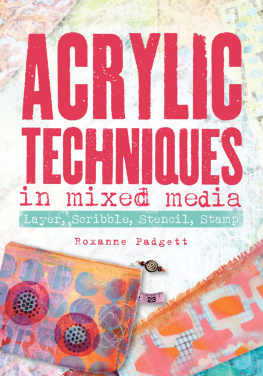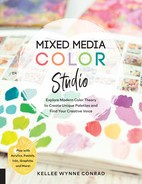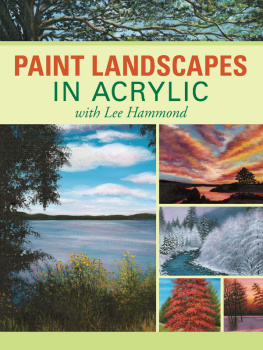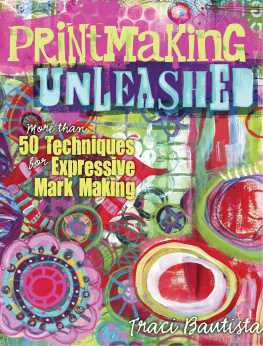Acrylic Techniques In Mixed Media
Layer, Scribble, Stencil, Stamp
ROXANNE PADGETT

Cincinnati, Ohio
www.createmixedmedia.com
Recommended Supplies
The following is a list of supplies used throughout this book. Dont feel like you need to rush out and get them all at once. Get a few now. Get a few later. Experiment and find materials you like to work with.
9 polyester all-purpose zipper
Acrylic paint
Artists crayons
Awl
Baby wipes
Black and white copies
Bone folder
Brads
Brayers
Buttons or beads
Canvas
Clips
Colored binder rings
Colored tape
Combing tools
Computer
Copic markers
Corded black elastic
Correction pens
Cotton fabrics
Craft knife
Crayons
Cutting mat
Embellishments
Embroidery floss
Fabric
Fabric sealant
Fine-point permanent marker
Gesso
Glazing medium
Gloss varnish
Glue sticks
Handheld drill and 116 (2mm) drill bit
Hole punch
Hot glue gun
Iron
Jump ring
Kitchen sponges
Large paper needle
Large white paper plates
Magazine pages
Manila folders
Matte medium
Miscellaneous mark-making tools including pizza wheels, tracing wheels, kitchen gadgets, toys, packing and recycled materials.
Needle
Needle-nose pliers
Paintbrushes
Painters tape
Paper
Paper cutter
Paper towels
Pencils
Permanent adhesive address labels
Permanent marker
Pinking shears
Plastic measuring tape
Pliers
Poster paint pens
Punches, including tag-shaped punch
Pushpins
Ruler
Safety pin
Scissors
Sewing machine
Small golf pencils
Small sponge rollers
Stamping ink
Stamps
Stapler
Stencil brushes
Stencils
Tacky glue
Thread
Transparencies, or overhead projector sheets
Water container
Wax
White cosmetic sponges
Wire
Wooden circles
Wooden clothespins
Introduction
It begins with color: a patch of red, a scribble of magenta, a splatter of orange. The colors express how I feel and think without saying a word. I continue painting: A drop of paint and an accidental spill add to the uniqueness of the piece. Stamping, rolling, stenciling, painting, building the layers that alternately reveal and conceal, creating combinations that I could not have expected. Lets collage some paper scraps and another layer of scribbled crayon lines. When do I stop? Get another piece of paper or canvas and see what happensthe possibilities are limitless.
As a child, I spent most of my time making stuff with items we had around the house. I didnt have many real art supplies; I had crayons, coloring books, scraps of fabric, scissors, tape, needle and thread. Simple media and techniques, like scribbling with a crayon, are still what I use most in my work. I am interested in using uncomplicated mediums and techniques to create multilayered works.
As a teaching artist, I have taught art classes to thousands of children and adults over twenty-five years. I have always been inspired by childrens ability to play and experiment with color, materials and techniques. I believe everyone is creative, not just the special few artists. I encourage students, young and old alike, to experiment with and use simple techniques and materials. You dont need a lot of fancy art materials to create. You have enough, and are enough, right now to be creative, to explore, to play and to express yourself. My goal with this book is to give you the tools to do just that.
The opening chapter of this book, , will walk you through the process of understanding color. Instead of painting a traditional color wheel, you can gain an understanding of color by painting sheets of paper. Each sheet can become background pieces for other techniques like mark making, stamping and stenciling.
The second chapter, , will help you overcome your fear of the blank page. When was the last time you picked up a crayon and just scribbled on a big sheet of paper? It can release you from the idea of a perfect white canvas or page. This is just one of many layering techniques to add to your mixed-media tool box.
The next two chapters focus on printmaking and painting techniques you can use on a variety of substrates, from paper products to textiles and painters canvas. Besides learning the techniques, youll also learn to make your own stencils, stamps and collagraph plates. Creating your own tools will give your work uniqueness, and you will be able to get what you want when you want it; you can create it yourself with what you have.
Once you have played with the different techniques, you will put it all together in the chapter. Experiment with how these techniques work together, mix and match techniques and color combinations, encourage mistakes and see what emerges.
By now you will have several pieces of fully layered lush paper and textiles that can be used for the eight projects. You will learn to create these projects step-by-step in the final section of the book. Create items that are uniquely yours and functional, including business cards, journals and even zippered bags.
Through playing and experimenting with these materials and techniques, your own personal style will emerge. Make mistakes, embrace them and keep going. Mistakes can be a doorway for unexpected discoveries, so leave your eyes and mind open for new opportunities you can build on. In the end, it is only a piece of a paper or cloth. You can always add another layer.
Tools and Materials
To create my art, I use everyday materials that are easily accessible and inexpensive. I like to see how far I can push my materials to express my ideas. I would encourage you to purchase a few materials to begin with, experiment with them and see what works for you. In the beginning, all you really need are some primary colors of paint, matte medium, a few crayons and a piece of paper or canvas.
PAINT
There is a wide variety of paints that can be purchased at art and craft stores and online. I primarily use acrylic paints. Acrylics come in a huge variety of colors, the paint dries quickly and they are easy to clean up. I like the color and quality of Liquitex and Blick basic paints.
PAINT MEDIUMS
There are many additives or mediums that can change the nature of how paint acts, from slowing down the drying time to thickening or thinning the paint without losing the pigment quality. I always have gesso and matte medium on hand for my mixed-media projects.
Gesso: A primer for substrates, including canvas, that you paint on as a base for painting and other mixed-media techniques. I use it on printed cottons and paper to change the surface quality. You can paint gesso in random areas of a substrate to create unexpected effects.












